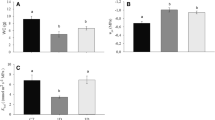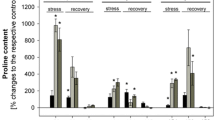Abstract
Plants are known for their high capacity to acclimatise to fluctuating environmental conditions. A wide range of environmental conditions can lead to suboptimal physiological efficiency. However, recent studies have shown that plants can withstand repeated periods of stress. To find out how they do it, we studied photosynthetic adjustments to repeated water stress in Aptenia cordifolia: a facultative, invasive CAM species. Plants were subjected to three cycles of water deficit, and photosynthetic parameters and chloroplast antioxidants were quantified to gain an understanding of the mechanisms by which they cope with repeated stress periods. Significant modification of the photosystems’ antenna and reaction centres was observed in plants subjected to previous water stress cycles, and this led to higher PSII efficiency than in plants challenged with drought for the first time. These findings underline the biological significance of stress memory and show how plants can adjust their photosynthetic apparatus to fluctuating environmental conditions and thus optimise photosynthesis and photoprotection under drought conditions.






Similar content being viewed by others
Abbreviations
- Chl:
-
Chlorophyll
- HPLC:
-
High-performance liquid chromatography
- PS:
-
Photosystem
- ROS:
-
Reactive oxygen species
- Toc:
-
Tocopherol
References
Amaral JS, Casal S, Torres D, Seabra RM, Oliveira BPP (2005) Simultaneous determination of tocopherols and tocotrienols in hazelnuts by a normal phase liquid chromatographic method. Anal Sci 21:1545–1548
Asada K (2006) Production and scavenging of reactive oxygen species in chloroplasts and their functions. Plant Physiol 141:391–396
Ballottari M, Mozzo M, Girardon J, Hienerwadel R, Bassi R (2013) Chlorophyll triplet quenching and photoprotection in the higher plant monomeric antenna protein Lhcb5. J Phys Chem B 117:11337–11348
Barajas-López JDD, Blanco NE, Strand T (2013) Plastid-to-nucleus communication, signals controlling the running of the plant cell. Biochim Biophys Acta Mol Cell Res 1833:425–437
Beckett RP, Marschall M, Laufer Z (2005) Hardening enhances photoprotection in the moss Atrichum androgynum during rehydration by increasing fast-rather than slow-relaxing quenching. J Bryol 27:7–12
Black CC, Osmond CB (2003) Crassulacean acid metabolism photosynthesis: ‘working the night shift’. Photosynth Res 76:329–341
Bond NA, Bumbaco KA (2015) Summertime potential evapotranspiration in eastern Washington State. J Appl Meteorol Climatol 54:1090–1101
Borland AM, Hartwell J, Weston DJ, Schlauch KA, Tschaplinski TJ, Tuskan GA, Yang X, Cushman JC (2014) Engineering crassulacean acid metabolism to improve water-use efficiency. Trends Plant Sci 19:327–338
Bruce TJA, Matthes MC, Napier JA, Pickett JA (2007) Stressful “memories” of plants: evidence and possible mechanisms. Plant Sci 173:603–608
Bussotti F, Ferrini F, Pollastrini M, Fini A (2013) The challenge of Mediterranean sclerophyllous vegetation under climate change: from acclimation to adaptation. Environ Exp Bot 103:80–98
Camarero JJ, Olano JM, Arroyo Alfaro SJ, Fernández-Marín B, Becerril JM, García-Plazaola JI (2012) Photoprotection mechanisms in Quercus ilex under contrasting climatic conditions. Flora Morphol Distrib Funct Ecol Plants 207:557–564
Cazzaniga S, Li Z, Niyogi KK, Bassi R, Dall’Osto L (2012) The Arabidopsis szl1 mutant reveals a critical role of β-carotene in photosystem I photoprotection. Plant Physiol 159:1745–1758
Cazzonelli CI (2011) Carotenoids in nature: insights from plants and beyond. Funct Plant Biol 38:833–847
Cela J, Munné-Bosch S (2012) Acclimation to high salinity in the invasive CAM plant Aptenia cordifolia. Plant Ecol Divers 5:403–410
Cela J, Arrom L, Munné-Bosch S (2009) Diurnal changes in photosystem II photochemistry, photoprotective compounds and stress-related phytohormones in the CAM plant, Aptenia cordifolia. Plant Sci 177:404–410
Chaves MM, Flexas J, Pinheiro C (2009) Photosynthesis under drought and salt stress: regulation mechanisms from whole plant to cell. Ann Bot 103:551–560
Chinnusamy V, Zhu JK (2009) Epigenetic regulation of stress responses in plants. Curr Opin Plant Biol 12:133–139
Chown SL, Huiskes AHL, Gremmen NJM, Lee JE, Terauds A, Crosbie K, Frenot Y, Hughes KA, Imura S, Kiefer K, Lebouvier M, Raymond B, Tsujimoto M, Ware C, Van de Vijver B, Bergstrom DM (2012) Continent-wide risk assessment for the establishment of nonindigenous species in Antarctica. Proc Natl Acad Sci 109:4938–4943
Cushman JC, Borland AM (2002) Induction of Crassulacean acid metabolism by water limitation. Plant Cell Environ 25:295–310
Davidson AM, Jennions M, Nicotra AB (2011) Do invasive species show higher phenotypic plasticity than native species and if so, is it adaptive? A meta-analysis. Ecol Lett 14:419–431
Davis SC, LeBauer DS, Long SP (2014) Light to liquid fuel: theoretical and realized energy conversion efficiency of plants using Crassulacean Acid Metabolism (CAM) in arid conditions. J Exp Bot 65:3471–3478
Deikman J, Petracek M, Heard JE (2012) Drought tolerance through biotechnology: improving translation from the laboratory to farmers’ fields. Curr Opin Biotechnol 23:243–250
Ding Y, Liu N, Virlouvet L, Riethoven JJ, Fromm M, Avramova Z (2013) Four distinct types of dehydration stress memory genes in Arabidopsis thaliana. BMC Plant Biol 13:229
Ding Y, Virlouvet L, Liu N, Riethoven JJ, Fromm M, Avramova Z (2014) Dehydration stress memory genes of Zea mays; comparison with Arabidopsis thaliana. BMC Plant Biol 14:141
Dodd AN, Borland AM, Haslam RP, Griffiths H, Maxwell K (2002) Crassulacean acid metabolism: plastic, fantastic. J Exp Bot 53:569–580
Esteban R, Barrutia O, Artetxe U, Fernández-Marín B, Hernández A, García-Plazaola JI (2015a) Internal and external factors affecting photosynthetic pigment composition in plants: a meta-analytical approach. New Phytol 206:268–280
Esteban R, Moran JF, Becerril JM, García-Plazaola JI (2015b) Versatility of carotenoids: an integrated view on diversity, evolution, functional roles and environmental interactions. Environ Exp Bot 119:63–75
Fernández-Marín B, Becerril JM, García-Plazaola JI (2010) Unravelling the roles of desiccation-induced xanthophyll cycle activity in darkness: a case study in Lobaria pulmonaria. Planta 231:1335–1342
Fey V, Wagner R, Bräutigam K, Pfannschmidt T (2005) Photosynthetic redox control of nuclear gene expression. J Exp Bot 56:1491–1498
Fleta-Soriano E, Pintó-Marijuan M, Munné-Bosch S (2015) Evidence of drought stress memory in the facultative CAM, Aptenia cordifolia: possible role of phytohormones. PLoS ONE 10(8):e0135391
Förster B, Osmond CB, Pogson BJ (2009) De novo synthesis and degradation of Lx and V cycle pigments during shade and sun acclimation in avocado leaves. Plant Physiol 149:1179–1195
Garcia-Plazaola JI, Esteban R, Fernandez-Marin B, Kranner I, Porcar-Castell A (2012) Thermal energy dissipation and xanthophyll cycles beyond the Arabidopsis model. Photosynth Res 113:89–103
Gruszecki WI, Strzałka K (2005) Carotenoids as modulators of lipid membrane physical properties. Biochim Biophys Acta Mol Basis Dis 1740:108–115
Havaux M, García-Plazaola JI (2014) Beyond non-photochemical fluorescence quenching: the overlapping antioxidant functions of zeaxanthin and tocopherols. In: Demmig-Adams B, Garab G, Adams W III, Govindjee (eds) Non-photochemical quenching and energy dissipation in plants, algae and cyanobacteria, vol 40. Springer, Dordrecht, pp 583–603
Herppich WB, Peckmann K (1997) Responses of gas exchange, photosynthesis, nocturnal acid accumulation and water relations of Aptenia cordifolia to short-term drought and rewatering. J Plant Physiol 150:467–474
IPCC (2012) Managing the risks of extreme events and disasters to advance climate change adaptation. In: Field CB, Stocker TF, Dahe Q (eds) A Special Report of Working Groups I and II of the Intergovernmental Panel on Climate Change. Cambridge University Press, Cambridge
Jahns P, Holzwarth AR (2012) The role of the xanthophyll cycle and of lutein in photoprotection of photosystem II. Biochim Biophys Acta Bioenerg 1817:182–193
Munné-Bosch S, Alegre L (2000) Changes in carotenoids, tocopherols and diterpenes during drought and recovery, and the biological significance of chlorophyll loss in Rosmarinus officinalis plants. Planta 210:925–931
Munné-Bosch S, Alegre L (2002) The function of tocopherols and tocotrienols in plants. Crit Rev Plant Sci 21:31–57
Murchie EH, Lawson T (2013) Chlorophyll fluorescence analysis: a guide to good practice and understanding some new applications. J Exp Bot 64:3983–3998
Neales TF, Patterson AA, Hartney VJ (1968) Physiological adaptation to drought in the carbon assimilation and water loss of xerophytes. Nature 219:469–472
Nicotra AB, Atkin OK, Bonser SP, Davidson AM, Finnegan EJ, Mathesius U, Poot P, Purugganan MD, Richards CL, Valladares F, van Kleunen M (2010) Plant phenotypic plasticity in a changing climate. Trends Plant Sci 15:684–692
Niinemets Ü, Kollist H, García-Plazaola JI, Hernández A, Becerril JM (2003) Do the capacity and kinetics for modification of xanthophyll cycle pool size depend on growth irradiance in temperate trees? Plant Cell Environ 26:1787–1801
Peckmann K, Herppich WB (1998) Effects of short-term drought and rewatering on the activity of mitochondrial enzymes and the oxidative capacity of leaf mitochondria from a CAM plant, Aptenia cordifolia. J Plant Physiol 152:518–524
Pfalz J, Liebers M, Hirth M, Grübler B, Holtzegel U, Schröter Y, Dietzel L, Pfannschmidt T (2012) Environmental control of plant nuclear gene expression by chloroplast redox signals. Front Plant Sci 3
Pintó-Marijuan M, Munné-Bosch S (2013) Ecophysiology of invasive plants: osmotic adjustment and antioxidants. Trends Plant Sci 18:660–666
Pintó-Marijuan M, Munné-Bosch S (2014) Photo-oxidative stress markers as a measure of abiotic stress-induced leaf senescence: advantages and limitations. J Exp Bot 65:3845–3857
Ruban AV, Johnson MP (2010) Xanthophylls as modulators of membrane protein function. Arch Biochem Biophys 504:78–85
Sahu PP, Pandey G, Sharma N, Puranik S, Muthamilarasan M, Prasad M (2013) Epigenetic mechanisms of plant stress responses and adaptation. Plant Cell Rep 32:1151–1159
Schweitzer O, Erell E (2014) Evaluation of the energy performance and irrigation requirements of extensive green roofs in a water-scarce Mediterranean climate. Energy Build 68:25–32
Takahashi S, Badger MR (2011) Photoprotection in plants: a new light on photosystem II damage. Trends Plant Sci 16:53–60
Thayer SS, Björkman O (1990) Leaf Xanthophyll content and composition in sun and shade determined by HPLC. Photosynth Res 23:331–343
Thornton PK, Ericksen PJ, Herrero M, Challinor AJ (2014) Climate variability and vulnerability to climate change: a review. Glob Change Biol 20:3313–3328
Treichel S (1975) Crassulacean acid metabolism in a salt-tolerant member of Aizoaceae: Aptenia cordifolia. Plant Sci Lett 4:141–144
Trewavas A (2003) Aspects of plant intelligence. Ann Bot 92:1–20
Vialet-Chabrand S, Dreyer E, Brendel O (2013) Performance of a new dynamic model for predicting diurnal time courses of stomatal conductance at the leaf level. Plant Cell Environ 36:1529–1546
Walter J, Nagy L, Hein R, Rascher U, Beierkuhnlein C, Willner E, Jentsch A (2011) Do plants remember drought? Hints towards a drought-memory in grasses. Environ Exp Bot 71:34–40
Walters RG (2005) Towards an understanding of photosynthetic acclimation. J Exp Bot 56:435–447
Walters RG, Rogers JJM, Shephard F, Horton P (1999) Acclimation of Arabidopsis thaliana to the light environment: the role of photoreceptors. Planta 209:517–527
Wasson AP, Richards RA, Chatrath R, Misra SC, Prasad SVS, Rebetzke GJ, Kirkegaard JA, Christopher J, Watt M (2012) Traits and selection strategies to improve root systems and water uptake in water-limited wheat crops. J Exp Bot 63:3485–3498
Winter K, Holtum JAM (2014) Facultative crassulacean acid metabolism (CAM) plants: powerful tools for unravelling the functional elements of CAM photosynthesis. J Exp Bot 65:3425–3441
Zarter CR, Adams Iii WW, Ebbert V, Adamska I, Jansson S, Demmig-Adams B (2006) Winter acclimation of PsbS and related proteins in the evergreen Arctostaphylos uva-ursi as influenced by altitude and light environment. Plant Cell Environ 29:869–878
Acknowledgments
We thank the Servei de Camps Experimentals and Serveis Científico-tècnics (Universitat de Barcelona) for their technical assistance. We are very grateful to the Generalitat de Catalunya’s Servei Meteorològic de Catalunya for recording and providing the meteorological data. We also thank Jana Cela and Verónica Tijero for their help with sampling, as well as the journal editor and reviewers who helped to improve the manuscript. We are also very grateful to Toffa Evans from the Language Services (University of Barcelona) for English corrections. M.P.-M. was supported by a fellowship from the Generalitat de Catalunya (2013 BP-B 00235). Support for the research was provided through the ICREA Academia prize awarded to S.M.-B. by the Generalitat de Catalunya.
Author information
Authors and Affiliations
Corresponding author
Electronic supplementary material
Below is the link to the electronic supplementary material.
Rights and permissions
About this article
Cite this article
Pintó-Marijuan, M., Cotado, A., Fleta-Soriano, E. et al. Drought stress memory in the photosynthetic mechanisms of an invasive CAM species, Aptenia cordifolia . Photosynth Res 131, 241–253 (2017). https://doi.org/10.1007/s11120-016-0313-3
Received:
Accepted:
Published:
Issue Date:
DOI: https://doi.org/10.1007/s11120-016-0313-3




